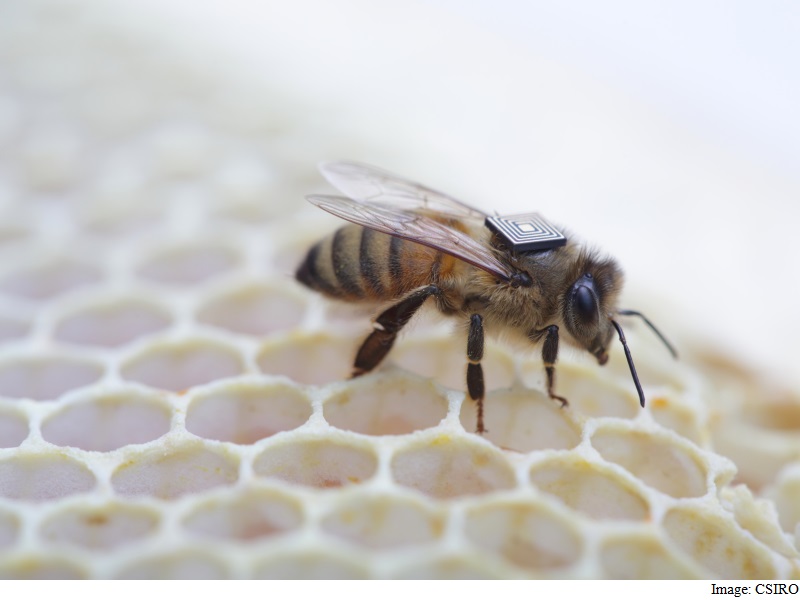- Home
- Science
- Science News
- Micro Sensors Stuck to Honey Bees to Help Solve Mass Deaths
Micro-Sensors Stuck to Honey Bees to Help Solve Mass Deaths

Australian scientists revealed Tuesday they are using micro-sensors attached to honey bees as part of a global push to understand the key factors driving a worldwide population decline of the pollinators.
There has been a sharp plunge in the population of honey bees, which pollinate about 70 percent of global crops, or one-third of food that humans eat including fruits and vegetables, raising fears over food security.
Researchers have said the falling hive numbers were caused by threats such as the sudden death of millions of adult insects in beehives - known as "colony collapse disorder" - a blood-sucking mite called Varroa, pesticides and climate change.
"The micro-sensors that we are using help us to ask different questions that we couldn't ask before because we've never really been able to quantify the behaviour of bees both out in the environment and in their hives," Gary Fitt from Australia's national science agency CSIRO told AFP.
The sensors, 2.5 millimetres (0.1 inches) in width and breadth and weighing 5.4 milligrams (0.0002 ounces) - lighter than pollen that bees collect - are glued to the back of European honey bees. Sophisticated data collection receptors are also built into hives.
The CSIRO working together with US technology firm Intel and Japanese conglomerate Hitachi is now offering free access to the sensor technology and data analytics to identify global patterns.
"What we are gathering with the sensors is environmental information from where the bees have been," said Fitt, the science director of the CSIRO's health and biosecurity division.
"It tells us about their changes in behaviour how often and how long they're foraging, whether they're feeding, whether they're collecting pollen, what they're doing in the hives.
"We can then see if we can interpret those changes to tell us how they are responding to different stresses."
About 10,000 bees and their hives in the southern island state of Tasmania have been tagged, with others set to be monitored in the cities of Sydney and Canberra.
Around the same number of bees in Brazil were also being monitored by researchers, with interest expressed from scientists in Europe and North America, Fitt said.
"(We'll) use the same approaches and ask similar questions but in different parts of the world to get a much bigger picture of the problem and collectively find solutions," he added.
Australia's bee populations have not been devastated as the island continent has yet to be affected by the Varroa mite.
In countries such as the US, beekeepers lost 42 percent of colonies over the 12 months to May this year - the second-worst year on record for US bee mortality, with the worst season reported in 2012-13, the US Department of Agriculture have estimated.
Catch the latest from the Consumer Electronics Show on Gadgets 360, at our CES 2026 hub.
- Samsung Galaxy Unpacked 2025
- ChatGPT
- Redmi Note 14 Pro+
- iPhone 16
- Apple Vision Pro
- Oneplus 12
- OnePlus Nord CE 3 Lite 5G
- iPhone 13
- Xiaomi 14 Pro
- Oppo Find N3
- Tecno Spark Go (2023)
- Realme V30
- Best Phones Under 25000
- Samsung Galaxy S24 Series
- Cryptocurrency
- iQoo 12
- Samsung Galaxy S24 Ultra
- Giottus
- Samsung Galaxy Z Flip 5
- Apple 'Scary Fast'
- Housefull 5
- GoPro Hero 12 Black Review
- Invincible Season 2
- JioGlass
- HD Ready TV
- Laptop Under 50000
- Smartwatch Under 10000
- Latest Mobile Phones
- Compare Phones
- Honor Magic 8 RSR Porsche Design
- Honor Magic 8 Pro Air
- Infinix Note Edge
- Lava Blaze Duo 3
- Tecno Spark Go 3
- iQOO Z11 Turbo
- OPPO A6c
- Samsung Galaxy A07 5G
- Lenovo Yoga Slim 7x (2025)
- Lenovo Yoga Slim 7a
- Lenovo Idea Tab Plus
- Realme Pad 3
- Moto Watch
- Garmin Quatix 8 Pro
- Haier H5E Series
- Acerpure Nitro Z Series 100-inch QLED TV
- Asus ROG Ally
- Nintendo Switch Lite
- Haier 1.6 Ton 5 Star Inverter Split AC (HSU19G-MZAID5BN-INV)
- Haier 1.6 Ton 5 Star Inverter Split AC (HSU19G-MZAIM5BN-INV)


![[Sponsored] Haier C90 OLED TV | Dolby Vision IQ, 144Hz OLED and Google TV in Action](https://www.gadgets360.com/static/mobile/images/spacer.png)









